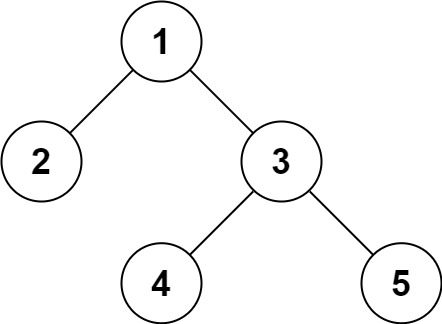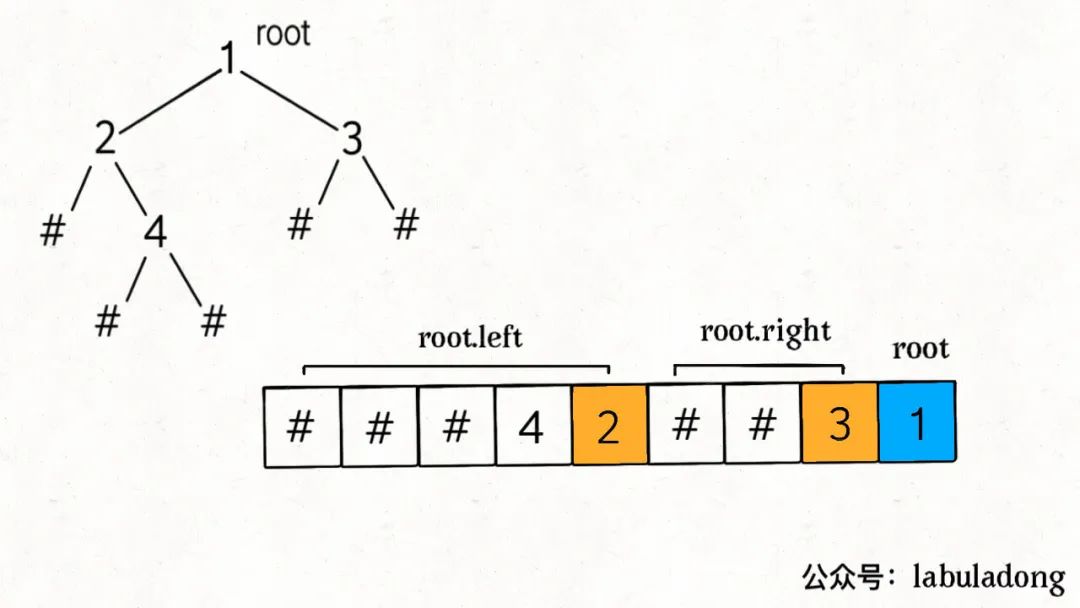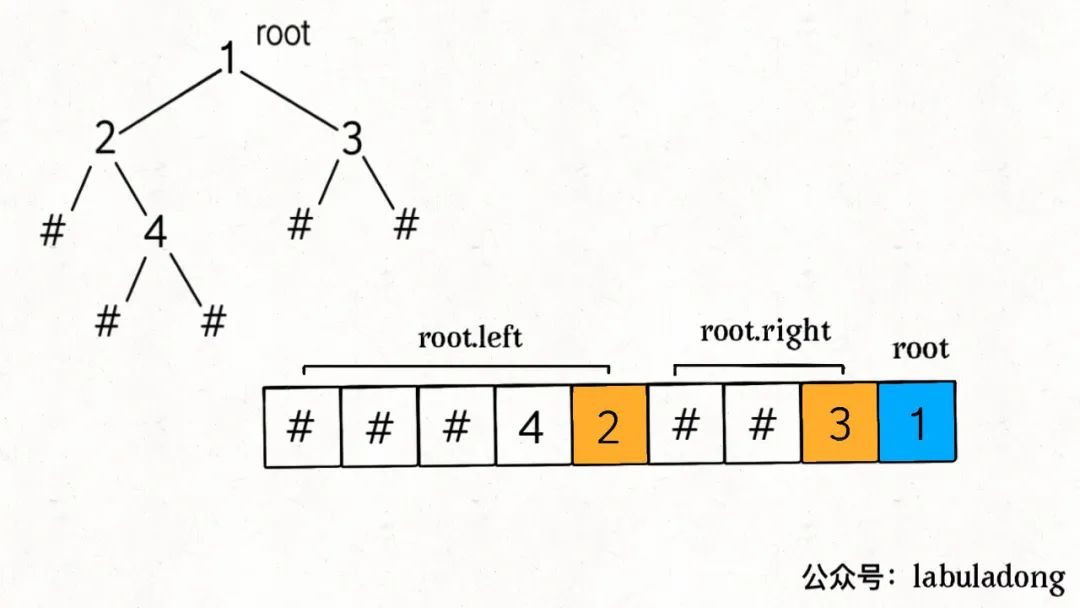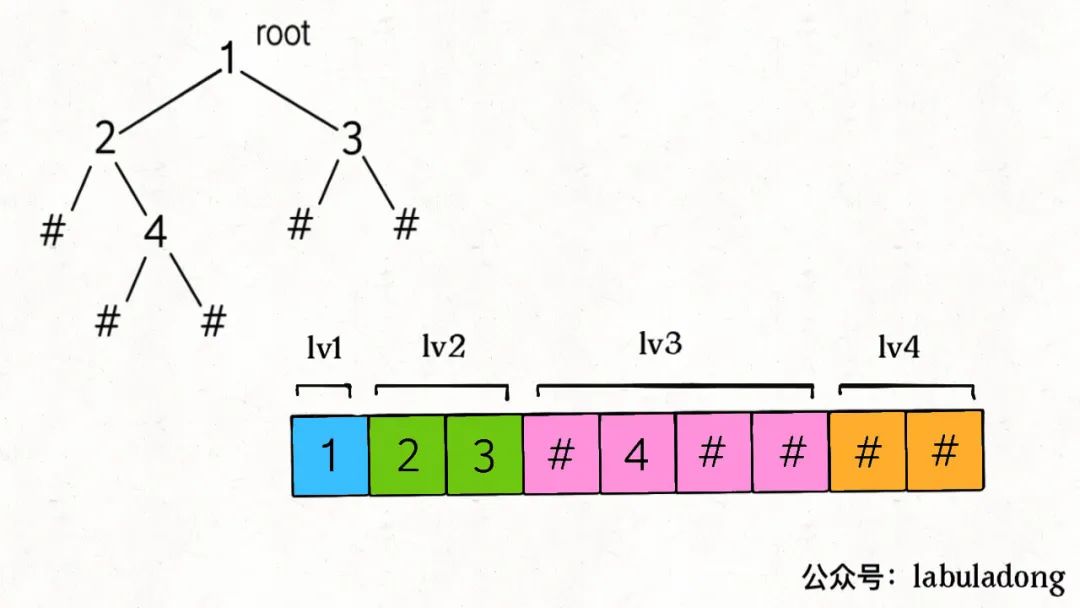297.二叉树的序列化和反序列化
# 题目描述
序列化是将一个数据结构或者对象转换为连续的比特位的操作,进而可以将转换后的数据存储在一个文件或者内存中,同时也可以通过网络传输到另一个计算机环境,采取相反方式重构得到原数据。
请设计一个算法来实现二叉树的序列化与反序列化。这里不限定你的序列 / 反序列化算法执行逻辑,你只需要保证一个二叉树可以被序列化为一个字符串并且将这个字符串反序列化为原始的树结构。
提示: 输入输出格式与 LeetCode 目前使用的方式一致,详情请参阅 LeetCode 序列化二叉树的格式。你并非必须采取这种方式,你也可以采用其他的方法解决这个问题。
示例 1:

输入:root = [1,2,3,null,null,4,5]
输出:[1,2,3,null,null,4,5]
2
示例 2:
输入:root = []
输出:[]
2
示例 3:
输入:root = [1]
输出:[1]
2
示例 4:
输入:root = [1,2]
输出:[1,2]
2
# 外地解法-二叉树前序遍历
前序遍历框架如下:
void traverse(TreeNode root) {
if (root == null) return;
// 前序位置的代码
traverse(root.left);
traverse(root.right);
}
2
3
4
5
6
7
根据前序遍历的框架,可将二叉树序列化,代码如下:

// 代表分隔符的字符
String SEP = ",";
// 代表 null 空指针的字符
String NULL = "#";
// 用于拼接字符串
StringBuilder sb = new StringBuilder();
/* 将二叉树打平为字符串 */
void traverse(TreeNode root, StringBuilder sb) {
if (root == null) {
sb.append(NULL).append(SEP);
return;
}
/****** 前序位置 ******/
sb.append(root.val).append(SEP);
/***********************/
traverse(root.left, sb);
traverse(root.right, sb);
}
2
3
4
5
6
7
8
9
10
11
12
13
14
15
16
17
18
19
20
21
调用完 traverse 函数后,sb 中的字符串应该是 1,2,#,4,#,#,3,#,#,。
现在,思考一下如何写 deserialize 函数,将字符串反过来构造二叉树。
首先我们可以把字符串转化成列表:
String data = "1,2,#,4,#,#,3,#,#,";
String[] nodes = data.split(",");
2
这样,nodes 列表就是二叉树的前序遍历结果,问题转化为:如何通过二叉树的前序遍历结果还原一棵二叉树?
根据我们刚才的分析,nodes 列表就是一棵打平的二叉树:

那么,反序列化过程也是一样,先确定根节点 root,然后遵循前序遍历的规则,递归生成左右子树即可:
/* 主函数,将字符串反序列化为二叉树结构 */
TreeNode deserialize(String data) {
// 将字符串转化成列表
LinkedList<String> nodes = new LinkedList<>();
for (String s : data.split(SEP)) {
nodes.addLast(s);
}
return deserialize(nodes);
}
/* 辅助函数,通过 nodes 列表构造二叉树 */
TreeNode deserialize(LinkedList<String> nodes) {
if (nodes.isEmpty()) return null;
/****** 前序遍历位置 ******/
// 列表最左侧就是根节点
String first = nodes.removeFirst();
if (first.equals(NULL)) return null;
TreeNode root = new TreeNode(Integer.parseInt(first));
/***********************/
root.left = deserialize(nodes);
root.right = deserialize(nodes);
return root;
}
2
3
4
5
6
7
8
9
10
11
12
13
14
15
16
17
18
19
20
21
22
23
24
25
26
我们发现,根据树的递归性质,nodes 列表的第一个元素就是一棵树的根节点,所以只要将列表的第一个元素取出作为根节点,剩下的交给递归函数去解决即可。
整体代码如下:
/**
* Definition for a binary tree node.
* public class TreeNode {
* int val;
* TreeNode left;
* TreeNode right;
* TreeNode(int x) { val = x; }
* }
*/
public class Codec {
// Encodes a tree to a single string.
public String serialize(TreeNode root) {
StringBuilder sb = new StringBuilder();
serialize(root, sb);
return sb.toString();
}
String SEP = ",";
String NULL = "#";
// 辅助函数,将二叉树存入StringBuilder
public void serialize(TreeNode root, StringBuilder sb){
if(root == null){
sb.append(NULL).append(SEP);
return;
}
// 前序位置
sb.append(root.val).append(SEP);
serialize(root.left, sb);
serialize(root.right, sb);
}
// Decodes your encoded data to tree.
public TreeNode deserialize(String data) {
// 将字符串转化为列表
LinkedList<String> nodes = new LinkedList<>();
for(String s : data.split(SEP)){
nodes.addLast(s);
}
return deserialize(nodes);
}
public TreeNode deserialize(LinkedList<String> nodes){
if(nodes.isEmpty()) return null;
// 根据前序遍历的规则,递归生成左右子树
// 列表最左侧
String first = nodes.removeFirst();
// 列表内包含的空指针信息
if(first.equals(NULL)) return null;
TreeNode root = new TreeNode(Integer.parseInt(first));
root.left = deserialize(nodes);
root.right = deserialize(nodes);
return root;
}
}
// Your Codec object will be instantiated and called as such:
// Codec ser = new Codec();
// Codec deser = new Codec();
// TreeNode ans = deser.deserialize(ser.serialize(root));
2
3
4
5
6
7
8
9
10
11
12
13
14
15
16
17
18
19
20
21
22
23
24
25
26
27
28
29
30
31
32
33
34
35
36
37
38
39
40
41
42
43
44
45
46
47
48
49
50
51
52
53
54
55
56
57
58
59
60
# 外地解法-二叉树后序遍历
二叉树的后续遍历框架:
void traverse(TreeNode root) {
if (root == null) return;
traverse(root.left);
traverse(root.right);
// 后序遍历的代码
}
2
3
4
5
6
7
明白了前序遍历的解法,后序遍历就比较容易理解了,我们首先实现 serialize 序列化方法,只需要稍微修改辅助方法即可:
/* 辅助函数,将二叉树存入 StringBuilder */
void serialize(TreeNode root, StringBuilder sb) {
if (root == null) {
sb.append(NULL).append(SEP);
return;
}
serialize(root.left, sb);
serialize(root.right, sb);
/****** 后序遍历位置 ******/
sb.append(root.val).append(SEP);
/***********************/
}
2
3
4
5
6
7
8
9
10
11
12
13
14
我们把对 StringBuilder 的拼接操作放到了后续遍历的位置,后序遍历导致结果的顺序发生变化:

关键的难点在于,如何实现后序遍历的 deserialize 方法呢?
是不是也简单地将关键代码放到后序遍历的位置就行了呢:
/* 辅助函数,通过 nodes 列表构造二叉树 */
TreeNode deserialize(LinkedList<String> nodes) {
if (nodes.isEmpty()) return null;
root.left = deserialize(nodes);
root.right = deserialize(nodes);
/****** 后序遍历位置 ******/
String first = nodes.removeFirst();
if (first.equals(NULL)) return null;
TreeNode root = new TreeNode(Integer.parseInt(first));
/***********************/
return root;
}
2
3
4
5
6
7
8
9
10
11
12
13
14
15
没这么简单,显然上述代码是错误的,变量都没声明呢,就开始用了?生搬硬套肯定是行不通的,回想刚才我们前序遍历方法中的 deserialize 方法,第一件事情在做什么?
deserialize 方法首先寻找 root 节点的值,然后递归计算左右子节点。那么我们这里也应该顺着这个基本思路走,后续遍历中,root 节点的值能不能找到?再看一眼刚才的图:

可见,root 的值是列表的最后一个元素。我们应该从后往前取出列表元素,先用最后一个元素构造 root,然后递归调用生成 root 的左右子树。注意,根据上图,从后往前在 nodes 列表中取元素,一定要先构造 root.right 子树,后构造 root.left 子树。
完整代码:
/**
* Definition for a binary tree node.
* public class TreeNode {
* int val;
* TreeNode left;
* TreeNode right;
* TreeNode(int x) { val = x; }
* }
*/
public class Codec {
// Encodes a tree to a single string.
public String serialize(TreeNode root) {
StringBuilder sb = new StringBuilder();
serialize(root, sb);
return sb.toString();
}
String SEP = ",";
String NULL = "#";
// 辅助函数,将二叉树存入StringBuilder
public void serialize(TreeNode root, StringBuilder sb){
if(root == null){
sb.append(NULL).append(SEP);
return;
}
serialize(root.left, sb);
serialize(root.right, sb);
// 后序位置
sb.append(root.val).append(SEP);
}
// Decodes your encoded data to tree.
public TreeNode deserialize(String data) {
// 将字符串转化为列表
LinkedList<String> nodes = new LinkedList<>();
for(String s : data.split(SEP)){
nodes.addLast(s);
}
return deserialize(nodes);
}
public TreeNode deserialize(LinkedList<String> nodes){
if(nodes.isEmpty()) return null;
// 根据后序遍历的规则,递归生成左右子树
// 列表最右侧
String last = nodes.removeLast();
// 列表内包含的空指针信息
if(last.equals(NULL)) return null;
TreeNode root = new TreeNode(Integer.parseInt(last));
// 从后往前在 nodes 列表中取元素,一定要先构造 root.right 子树,后构造 root.left 子树。
root.right = deserialize(nodes);
root.left = deserialize(nodes);
return root;
}
}
// Your Codec object will be instantiated and called as such:
// Codec ser = new Codec();
// Codec deser = new Codec();
// TreeNode ans = deser.deserialize(ser.serialize(root));
2
3
4
5
6
7
8
9
10
11
12
13
14
15
16
17
18
19
20
21
22
23
24
25
26
27
28
29
30
31
32
33
34
35
36
37
38
39
40
41
42
43
44
45
46
47
48
49
50
51
52
53
54
55
56
57
58
59
60
61
# 外地解法-二叉树层次遍历
层级遍历二叉树的代码框架:
void traverse(TreeNode root) {
if (root == null) return;
// 初始化队列,将 root 加入队列
Queue<TreeNode> q = new LinkedList<>();
q.offer(root);
while (!q.isEmpty()) {
TreeNode cur = q.poll();
/* 层级遍历代码位置 */
System.out.println(root.val);
/*****************/
if (cur.left != null) {
q.offer(cur.left);
}
if (cur.right != null) {
q.offer(cur.right);
}
}
}
2
3
4
5
6
7
8
9
10
11
12
13
14
15
16
17
18
19
20
21
22
上述代码是标准的二叉树层级遍历框架,从上到下,从左到右打印每一层二叉树节点的值,可以看到,队列 q 中不会存在 null 指针。
不过我们在反序列化的过程中是需要记录空指针 null 的,所以可以把标准的层级遍历框架略作修改:
void traverse(TreeNode root) {
if (root == null) return;
// 初始化队列,将 root 加入队列
Queue<TreeNode> q = new LinkedList<>();
q.offer(root);
while (!q.isEmpty()) {
TreeNode cur = q.poll();
/* 层级遍历代码位置 */
if (cur == null) continue;
System.out.println(root.val);
/*****************/
q.offer(cur.left);
q.offer(cur.right);
}
}
2
3
4
5
6
7
8
9
10
11
12
13
14
15
16
17
18
这样也可以完成层级遍历,只不过我们把对空指针的检验从「将元素加入队列」的时候改成了「从队列取出元素」的时候。
那么我们完全仿照这个框架即可写出序列化方法:
String SEP = ",";
String NULL = "#";
/* 将二叉树序列化为字符串 */
String serialize(TreeNode root) {
if (root == null) return "";
StringBuilder sb = new StringBuilder();
// 初始化队列,将 root 加入队列
Queue<TreeNode> q = new LinkedList<>();
q.offer(root);
while (!q.isEmpty()) {
TreeNode cur = q.poll();
/* 层级遍历代码位置 */
if (cur == null) {
sb.append(NULL).append(SEP);
continue;
}
sb.append(cur.val).append(SEP);
/*****************/
q.offer(cur.left);
q.offer(cur.right);
}
return sb.toString();
}
2
3
4
5
6
7
8
9
10
11
12
13
14
15
16
17
18
19
20
21
22
23
24
25
26
27
28
层级遍历序列化得出的结果如下图:

可以看到,每一个非空节点都会对应两个子节点,那么反序列化的思路也是用队列进行层级遍历,同时用索引 i 记录对应子节点的位置:
/* 将字符串反序列化为二叉树结构 */
TreeNode deserialize(String data) {
if (data.isEmpty()) return null;
String[] nodes = data.split(SEP);
// 第一个元素就是 root 的值
TreeNode root = new TreeNode(Integer.parseInt(nodes[0]));
// 队列 q 记录父节点,将 root 加入队列
Queue<TreeNode> q = new LinkedList<>();
q.offer(root);
for (int i = 1; i < nodes.length; ) {
// 队列中存的都是父节点
TreeNode parent = q.poll();
// 父节点对应的左侧子节点的值
String left = nodes[i++];
if (!left.equals(NULL)) {
parent.left = new TreeNode(Integer.parseInt(left));
q.offer(parent.left);
} else {
parent.left = null;
}
// 父节点对应的右侧子节点的值
String right = nodes[i++];
if (!right.equals(NULL)) {
parent.right = new TreeNode(Integer.parseInt(right));
q.offer(parent.right);
} else {
parent.right = null;
}
}
return root;
}
2
3
4
5
6
7
8
9
10
11
12
13
14
15
16
17
18
19
20
21
22
23
24
25
26
27
28
29
30
31
32
33
整体代码:
/**
* Definition for a binary tree node.
* public class TreeNode {
* int val;
* TreeNode left;
* TreeNode right;
* TreeNode(int x) { val = x; }
* }
*/
public class Codec {
String SEP = ",";
String NULL = "#";
// Encodes a tree to a single string.
public String serialize(TreeNode root) {
if(root == null) return "";
StringBuilder sb = new StringBuilder();
Queue<TreeNode> q = new LinkedList<>();
q.offer(root);
while(!q.isEmpty()){
TreeNode cur = q.poll();
// 层次遍历
if(cur == null){
sb.append(NULL).append(SEP);
continue;
}
sb.append(cur.val).append(SEP);
q.offer(cur.left);
q.offer(cur.right);
}
return sb.toString();
}
// Decodes your encoded data to tree.
public TreeNode deserialize(String data) {
if(data.isEmpty()) return null;
String[] nodes = data.split(SEP);
// 第一个元素就是root的值
TreeNode root = new TreeNode(Integer.parseInt(nodes[0]));
// 队列q记录父节点,将root加入队列
Queue<TreeNode> q = new LinkedList<>();
q.offer(root);
for(int i = 1; i <nodes.length;){
// 队列中存的都是父节点
TreeNode parent = q.poll();
// 父节点对应的左侧子节点
String left = nodes[i++];
if(!left.equals(NULL)){
parent.left = new TreeNode(Integer.parseInt(left));
q.offer(parent.left);
}else {
parent.left = null;
}
// 父节点对应的右侧节点
String right = nodes[i++];
if(!right.equals(NULL)){
parent.right = new TreeNode(Integer.parseInt(right));
q.offer(parent.right);
}else {
parent.right = null;
}
}
return root;
}
}
// Your Codec object will be instantiated and called as such:
// Codec ser = new Codec();
// Codec deser = new Codec();
// TreeNode ans = deser.deserialize(ser.serialize(root));
2
3
4
5
6
7
8
9
10
11
12
13
14
15
16
17
18
19
20
21
22
23
24
25
26
27
28
29
30
31
32
33
34
35
36
37
38
39
40
41
42
43
44
45
46
47
48
49
50
51
52
53
54
55
56
57
58
59
60
61
62
63
64
65
66
67
68
69
70
71
72
73
74
75
